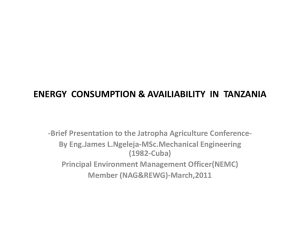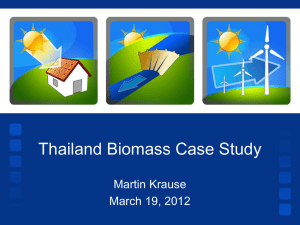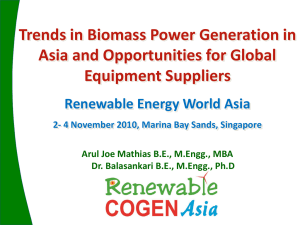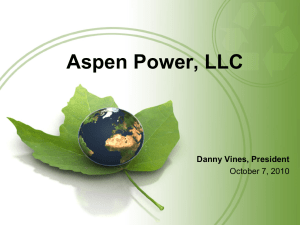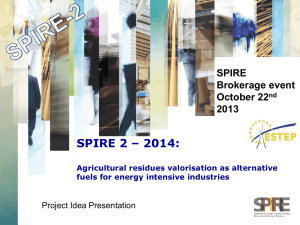BIOMASS UTILIZATION IN MALAYSIA: CURRENT - Biomass-SP
advertisement
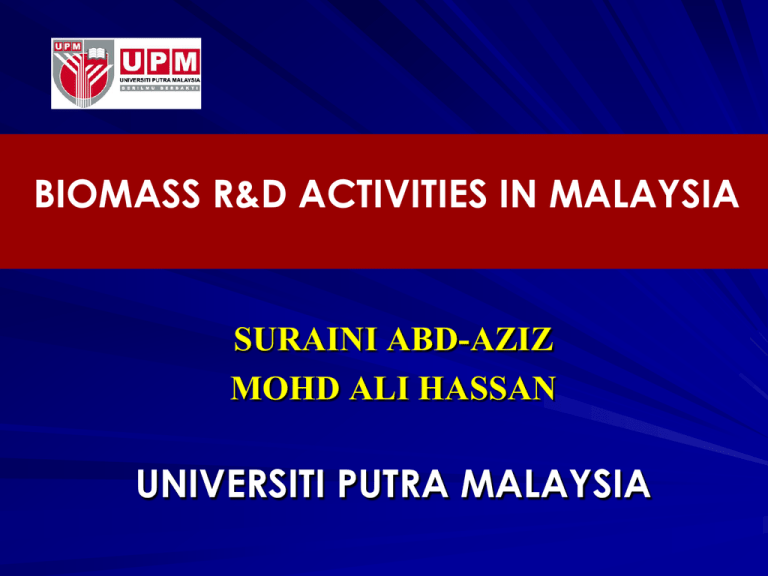
BIOMASS R&D ACTIVITIES IN MALAYSIA SURAINI ABD-AZIZ MOHD ALI HASSAN UNIVERSITI PUTRA MALAYSIA INTRODUCTION – What is Biomass? Organic matter available on renewable basis Agricultural crops e.g. sugarcane, cassava, corn Agricultural residues e.g. rice straw, cassava rhizome, corncobs Wood & wood residues e.g. fast-growing trees, wood waste from wood mill Waste stream e.g. rice husks from rice mills, molasses & bagasse from sugar refineries, residues from palm oil mills, MSW Biomass as an Alternative ? Shifting of paradigm towards biomass – Renewable energy – Sustainable – Environmentally friendly – Abundant – Untapped energy Uncertainties of biomass – Technological proven ? – Economically feasible ? – Constant supply ? (quality and quantity) – Availability & distribution ? (worldwide) Biomass in Malaysia Biomass – by-products with no or low profit generated from agricultural or industrial processes Main sources of biomass in Malaysia – Domestic wastes (MSW) – Agricultural residues – Animal wastes – Effluent sludge/wastewater – Wood chips Biomass resources: Agricultural residues Most abundant in Malaysia (> 70 million tonnes annually) Production of biomass throughout the year Main contributor of biomass – palm oil industry – Oil Palm Empty fruit bunches (OPEFB) – Palm oil mill effluent (POME) – Mesocarp fiber – Palm kernel shells – Palm kernel cake (residue) Mainly ligno-cellulosic materials Wood industry 4% Palm Oil 94% Rice 1% Sugarcane 1% Palm Oil Industry: Biomass Biomass production (2007) – Empty fruit bunch (EFB) – 15 million tonnes – Palm kernel shell - 8 million tonnes – Mesocarp fiber – 5 million tonnes – Abundant and concentrated in the mills (business as usual) New Business and Products from Palm Biomass Standardised biomass available “business as usual” Palm Oil Mill Effluent 50 million t/yr “zero emission” Bioplastic (PLA) or Bioethanol Compost Oil Palm Empty Fruit Bunch 16 million t/yr waste-to-wealth + water recycling Pre-treatment and Saccharification Bio-acids Sugars Fermentation in bioreactors Biomass Energy Biogas, CH4 (+ Biohydrogen) Bioplastic (PHA) 7 Adding Value to Palm Biomass Paradigm shift towards biomass – – – – Not waste Renewable Sustainable Under-utilised resource Uncertainties of biomass – – – – Technological proven ? Economically feasible ? Quality and quantity ? Availability & distribution ? value chain fuel feed fiber food fine chemicals 8 Thermal conversion: Biomass Thermal conversion of biomass Mainly in power/electricity generation Commercially used in the industries – Palm oil mills – boilers and steam turbines – Landfills – methane combustion Technology proven and high demand for energy Low efficiency boiler system – meant for waste disposal in the mill Biological conversion : CH4 Generation Collaborative Partners – Universiti Putra Malaysia, Kyushu Institute of Technology, FELDA Palm Industries & Sumitomo Heavy Industries CH4 generation from POME anaerobic treatment Pilot plant operation - 500 m3 improved design methane tank, POME holding tank, settling tank, gas scrubber, gas storage tank Conversion into electricity using gas engine PHASE 1 Gas Stack NaOH Tank Gas Scrubber Gas Storage Tank Methane Tank Discharge Gas Utilization Sludge Recycle Raw POME POME Storage PHASE 2 Biological Conversion : Organic Acids Collaborative partners – UPM, FELDA, KIT Established fermentation technology of organic acids from POME anaerobic treatment Production of acetic, propionic and butyric acids Up scaling the process to pilot plant operation RAW POME ANAEROBIC TREATMENT PURIFIED ORGANIC ACIDS Biological Conversion : Bioplastics Collaborative Partners - UPM, FELDA, KIT Utilization of acetic, propionic and butyric acids from POME Fermentation of organic acids into poly-hydroxyalkanoates The whole process will utilize excess energy from biogas plant Current stage – Distillation of organic acids and downstream processing of PHA Biological Conversion : Bio-compost Organic compost was successfully produced using POME sludge, shredded EFB, MSW and domestic sewage sludge Good properties such as pH 6-8, C/N 15 and comply to USEPA standards Performance was comparable with commercial composts Suitable for vegetables and ornamental plants Commercially available Biological Conversion : Animal Feed Palm-based feedstock: – Oil palm fronds with added nutrient supplements – Palm press fiber – Palm kernel cake – POME sludge Sago-based feedstock: – Pith residue (starch) Most of the feedstocks from palm-based and sagobased are commercially available Biological Conversion : Others New developments: – Enzyme production by SSF (cellulase, amylase) – Cellulosic bioethanol/biobutanol – Biohydrogen – Acetone-butanol-ethanol (ABE) – Mushroom cultivation Municipal Solid Waste : Biomass Malaysia generates an estimated 20,000 tons of solid waste per day The life span of landfills : 5 – 10 years only, 80% of current landfills will be closed in two years Non biodegradable plastics is widely used in supermarkets Malaysian government recognizes the importance of preserving the environment by promoting recycling (3R) Municipal Solid Waste : Biomass Energy (methane) for power/ electricity generation – 1st Independent Power Producer operating at Ayer Hitam Landfill, 2 MW Chemicals – Organic acids production – lactic, acetic, propionic and butyric acids – Bioplastics – PHA or poly-lactate Fertilizer – Bio-compost Solid Waste Organic Waste Bacteria Zeolite Liquid Waste Solid Waste Organic Acid Mixture SEPARATOR FILTER & PRESS BIO-REACTORS COMPOSTING SYSTEM Organic Acid Liquid Organic Acid Mixture Water Concentrate Organic Acid DRYER FILTER Water Diesel Lactic Acid BOILER FRACTIONAL DISTILLER EVAPORATOR Acetic Acid & Propionic Acids NaOH BIO-REACTORS DRYER PHA COMPOST NaOH TANK Challenges : Biomass Utilization Biomass has great potential as renewable resources Two major problems: – Technological shortcomings in realization of fermentable products from biomass Complex and sensitive system (biological agents) Production of several products in a single process Complexity in downstream processing – Socio-economics Not competitive compared to fossil fuels Accountability in pollution and global warming Sustainability of process and technology Outlook : Biomass Utilization Malaysia has great potential in biomass utilization as renewable resources Significant reduction in GHG emission – to achieve sustainable development via quantification of emission limitation and reduction of GHG under Kyoto Protocol – Clean Development Mechanism (CDM) projects generate Certified Emission Reduction (CER) for sale or export – The CER can be used towards developed nations commitments to mitigate their GHG emissions Biomass utilization promises sustainable development of both the industry and environment Acknowledgements Universiti Putera Malaysia Kyushu Institute of Technology, Japan JICA JSPS FELDA MOSTI, Malaysia





